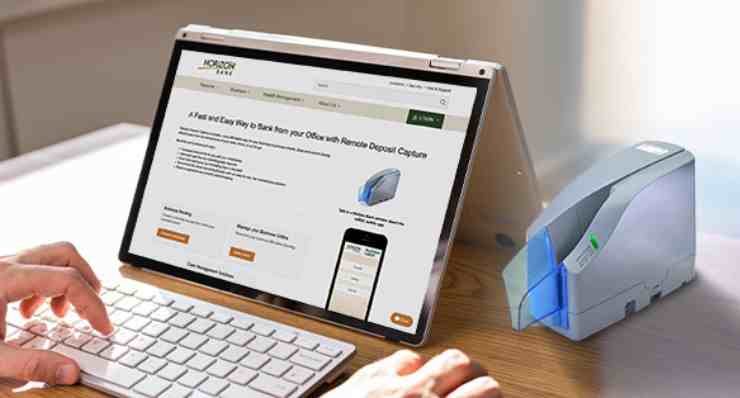Some firms struggle with remaining organized while worrying about missing or lost checks. Going through the stress of running to the bank to make transactions can be hectic at times. However, remote deposit capture is a much easier and less stressful way to attend to your cheques. You don’t need to worry anymore because remote deposit capture will let you stay productive and focused on your business. You must be unsure of the meaning of remote deposit capture and why it is crucial for you as a businessperson. Checks are safe with remote deposit capture, which also improves cash flow and saves time and money. You will learn more about the benefits, potential risks of using remote deposit capture and how it work..
Remote Deposit Capture
Remote deposit capture is a digital technique that enables banks to accept checks for deposit by using electronic images rather than the original, physical paper counterparts. In order to utilize remote deposit capture, a bank customer must sign and annotate the check “for deposit only,” take pictures or scans of the check’s front and back, and send the information electronically to the bank through a computer, smartphone, or cellular network.
You can physically deposit checks online with a Remote Deposit Capture.
You can also
- Scan a check
- Input check information
- Deposit a check remotely
- Examine deposit history
- View and download activity reports using the user-friendly interface.
How Does Remote Deposit Capture Work?
Remote deposit capture makes banking consumers’ lives easier, but banks will also benefit from it. At the very least, banks do not carry or pick up physical cheques from ATMs as frequently.
Banks provide certain clients with remote deposit capture services. Not all customers receive these services. When a bank provides this service to a customer, they often put a scanner on the customer’s property. The majority of banks impose a monthly fee to install this device.
Nevertheless, depending on the amount of business the organization gives the bank, this fee can be eliminated. The customer scans the check, and after that, the data is digitally transmitted to the bank.
The bank utilizes this data to create a duplicate copy of the original check, which is subsequently forwarded to the clearinghouse for additional processing. Typically, banks provide the customer with instant credit. However, this is dependent on the customer’s credit history and their interaction with the bank. Even if credit is not given right away, it becomes available within a few business days.
Most banks give their customers a few days after the checks have been processed to destroy them. Some banks, however, demand that customers keep their checks on hand for a longer amount of time. Furthermore, bank institutions have the ability to reject starter checks, traveller’s checks, and checks that are made payable to someone other than the account holder using remote deposit techniques.
Benefits of Remote Deposit Capture
Corporate clients all across the world frequently use remote deposit capture. The usage of this facility has a number of financial advantages. The following is a list of some of the financial benefits:
- It lowers the amount of manual deposit preparatory work.
- It reduces need for travels to the bank.
- RDC allows for later deposits and faster money access.
- It notifies users through email when deposits are received by the bank in real-time.
provides many reporting options for data access, export, and exporting of images of scanned checks and accompanying documents. - It accommodates numerous authorized accounts
- Since there is no requirement to visit a branch or ATM in order to deposit checks, businesses can draw in new clients who value convenience and can work with clients in far-flung places more simply.
Who Uses Remote Deposit Capture?
#1. Businesses
The technology for remote deposits was originally used by businesses. The volume of checks that organizations get makes it necessary for them to move promptly to make money accessible for operations, payroll, and growth.
#2. Individuals
Customers value the simplicity of remote deposits as well. People who are constantly on the go increasingly demand checking accounts that let them deposit checks using a mobile device, avoiding trips to bank branches.
#3. Other Organizations
Remote deposit is used by nonprofits, authorities, and other organizations. The technology is readily accessible, and businesses can select less expensive gear and services when doing so makes the most sense.
Where to Find Services for Remote Deposit
Most banks and credit unions would be able to assist you in setting up remote deposit. It’s especially simple if you’re a customer; just download your bank’s app, where it undoubtedly already is.
Remote Deposit Capture Machine
The Remote Deposit Capture machine is a desktop scanner that you may use to deposit checks from the convenience of the office by connecting to your office computer and the internet. Using a remote deposit capture machine, you can scan checks and submit deposits from your customers. Additionally, you have the option of scanning checks you receive and sending the resulting digital files to a financial institution for posting and clearing. Some banking institutions combine the RDC service with optional ACH conversion and clearing. One effective method for remote deposit capture is mobile deposit capture.
What Is Mobile Check Deposit?
A mobile check deposit is a mobile banking tool called enables you to use your mobile device to deposit checks into your bank account. You can deposit checks into your account from anywhere, whether that be at home, at work, or while on vacation, as opposed to doing it at an ATM, a drive-through window at your bank, or with a teller inside the lobby.
How Does Mobile Check Deposit Work?
Mobile check deposit works using remote deposit capture technology. When you take a photo of your check, it’s similar to scanning a photograph or document to make a digital copy on your computer.
Here’s a simple guide to what mobile check deposit generally looks like in action:
- If you haven’t already, you download the mobile banking app from your bank and create a special login.
- After logging in, the menu for mobile check deposit is available on the app.
- After that, sign the check back as you would if you were depositing it at a branch (or in accordance with the guidelines the bank’s app provides for how to endorse a check).
- Decide the account you wish to deposit the check into.
- Type in the amount you need for the check.
- Use the camera on your mobile device to take pictures of the check’s front and back.
- If the deposit details are accurate, double-check them before clicking submit to proceed with the deposit.
Mobile check deposit is becoming more widely available from banks and credit unions as a simple alternative for customers to fund their accounts. If you’re unsure whether your financial institution accepts mobile check deposits, you may check their website or get in touch with a branch, and they should be able to let you know if it applies to your account.
Remote deposit capture enables you to replace your paper check with a digital version.
The information is encrypted and sent to your bank as soon as you scan and upload images of your check and make a deposit request. Then it goes through furtherfbreviewing after which you will receive the funds.
Remote Deposit Capture Software
A remote deposit capture software is a program that is installed and runs on your computer, and communicates with your bank when needed via a secure connection that is launched from within the program. It is typically a good option for scanning large numbers of checks at once, or when your RDC system needs to interact with other programs on your computer.
Examples of Remote Deposit Capture Software Include
- Brochures
- Alogent
- Fiserv
- Parascript
- RemoteDepositCapture.com
- RP Solutions
- FTNI
Pros of Remote Deposit Capture Software
- It can operate without a connection to the Internet
- Operator must have physical access to that machine because it is usually confined to one computer. This is to reduce fraud duplication.
- Large numbers of checks can be swiftly scanned and then uploaded all at once.
- If RDC can collaborate with other programs, it would be ideal.
Cons of Remote Deposit Capture Software
- Larger program places higher demands on the system resources of your computer.
- You can either temporarily store or permanently save sensitive information on your hard drive.
- Not recommended for shared or public computers, or for those at risk of malware infection
- Due to the effectiveness of administering the entire application, most banks have switched from client-based to cloud-based systems.
Remote Deposit Capture Risks
RDC has potential risks in addition to those connected with the conventional check deposit method, as is the case with any new technology. Although, most commercial banks today have been successful in reducing the dangers brought on by remote deposit capture technology. Therefore, remote deposit capture is typically considered to be a secure method of accelerating a company’s cash flow.
This is the reason why businesses all over the world focus more on the advantages of remote deposit capture than the risks. This is seen from the rapid rate at which numerous organizations around the world are using this technology development.
The most frequent potential risks that RDC has found are described in detail in this section.
#1. High Risk of Fraud
One of the potential risks of the remote deposit capture technique is that it increases the likelihood of fraud when people use it. Numerous frauds of different kinds are connected to this procedure. Following are a few of the well-known ones:
(a.) Counterfeits
Banks have access to some of the most cutting-edge technology. However, there are still restrictions on the bank’s ability to examine the check. Rather than electronically scrutinizing a check, the institutions may perform a better job of physically verifying its authenticity.
Many con artists are aware of cutting-edge digital technology that they can use to produce fake checks that seem just like the real thing when scanned. Employees of the corporate client may attempt to do this while stealing money.
(b.) Re-deposit
The original check stays with the corporate customer when a check is deposited electronically via remote deposit capture. Sometimes, these checks are not properly discarded. As a result, clients may mistakenly re-deposit these checks. Banks, however, take fraud very seriously.
They have mechanisms in place to identify these fraudulent redeposits as a result. Banks impose severe fines for such redeposits. To discourage attempts at fraud, this is done. As a result, the corporation may incur significant financial losses as a result of charges and fees due to a few clerks’ administrative mistakes
(c.) Data Modification
The remote deposit capture machine frequently uses optical character recognition technology to capture data from the check. However, the user can then change this data both at the customer’s site and on the bank’s end.
It is very likely that incorrect data will be entered, either intentionally or due to administrative mistakes. It’s conceivable that more or less money will be taken from the customer’s account in each scenario. Additionally, the process is riskier simply because data can be changed.
#2. Check Rejection
The banks have very strict requirements for visual clarity when it comes to remote deposit capture. To make sure that the images are clear and simple for the machines to read, there are industry-wide standards that must be adhered to. However, in many instances, as machines age, they lose precision and clarity. The pictures taken don’t meet the requirements for quality as a result. In some situations, the checks are processed right away, but the banks later cancel them.
These check denials might be very challenging to find. The corporate customer can find it challenging to reconcile the rejected checks with their books of accounts if they are unable to track them.
#3. Insurance Protection
Finally, because remote deposit capture procedures are so susceptible to fraud, they have an effect on the organization’s insurance requirements. Corporate clients need to be certain that their insurance will cover any potential responsibility resulting from scams involving remote deposit capture.
Insurance companies might not always cover a loss, in which case businesses might need to buy supplementary insurance. Commercial banks can assist clients with their insurance needs directly. However, it’s crucial that clients are aware of these hazards.
What Is the Difference Between Remote Deposit Capture and Mobile Deposit?
You can deposit checks into your personal checking account using a remote deposit capture without going to a bank or ATM. With the help of your smartphone, you may complete this mobile deposit from any location.
How Much Does Remote Deposit Capture Cost?
Without having to leave your office or visit the banking center, you can make an unlimited number of deposits and take advantage of later cutoff times. Yes. The program has a monthly fee of $15.
How Long Does a Remote Check Deposit Take?
Except when there are issues with the image, a mobile deposit doesn’t take any longer than a regular check deposit. Although it can take up to two full business days, most checks pass in less than a full business day.
What Is the Limit for Mobile Deposits at Bank of America?
Although this service allows you to scan an infinite number of checks each month, we recommend no more than 125. The top deposit amount each day is $999,999.99.
What Are the Qualifications for Mobile Deposit?
To make a mobile deposit, it is essential to have
- A current active Mobile App user.
- A checking account.
- A working email address is necessary.
- At least 18 years old; in good standing on all accounts (savings, checking, loans); and a member for at least 45 days.
What Are the Check Image Requirements for Remote Deposit Capture
The check images used for remote deposit capture must adhere to a variety of specifications, including having
- A minimum dot per inch (DPI)
- It should be very clear
- Not being too large
- It should be in the JPEG file format.
Is Remote Deposit Instant?
Normally, it takes one to three business days for your money to be available, but it may take up to five.
Do Banks Verify Checks Before Cashing?
Banks must confirm if the transaction can be completed because paper checks do not have any inherent monetary value.
How Much Are Cash Deposit Charges in the USA?
When you don’t maintain a minimum balance in your account, banks impose fines. That sum ranges from roughly $100 to $500.
Is Remote Deposit Capture an EFT?
By avoiding the requirement to deposit checks in the bank, you may reallocate your valuable office time by using EFT Network Remote Deposit Capture technology.
In Conclusion.
With a Remosit deposit capture, you can effortlessly deposit checks using PCs, tablets, or cellphones. Due to the 24/7 support, checks can be deposited any time of day or night, not only during standard banking hours, thereby eliminating the need for trips to the bank. A lot of people use remote deposit capture for paychecks, gift checks, refund checks, and any other checks that they receive. The technology may be used by businesses to deposit checks that they receive from their clients. RDC facilitates the development of a more seamless relationship between you and your devoted clients.
FAQs
How long does it take for a check deposit to be approved?
A check should typically clear in one or two business days. Although, sometimes it may be kept for a longer period of time, for example, if it is a big deposit check or an international check. You can check the policies of your bank to find out how long a check approval lasts.
How do banks verify checks?
Banks do verify checks by examining the balance of the account the check was sent from. It’s important to remember that a bank won’t check your check before processing it, so if you attempt to cash a faulty check, you can be charged. If there is no money in the account, the bank checks and the cheque bounces.
Can I withdraw $20000 from bank?
You can withdraw as much money as you like from your bank account unless your bank has imposed its own withdrawal cap. You have to check with your bank to know the limits.
- LEAD MANAGEMENT: Guide And Best Practices
- Hot new business ideas 2023 with a 100% success rate. Find 10 of them here (+ all you need)
- HOW TO MAKE A FACEBOOK BUSINESS PAGE: Step-By-Step Guide
- Bakery business plan (Download + 3 years free financials)
- HOW TO FIND REMOTE JOBS in 2023: Best Easy Guide






